2017 MITSUBISHI iMiEV brakes
[x] Cancel search: brakesPage 13 of 296
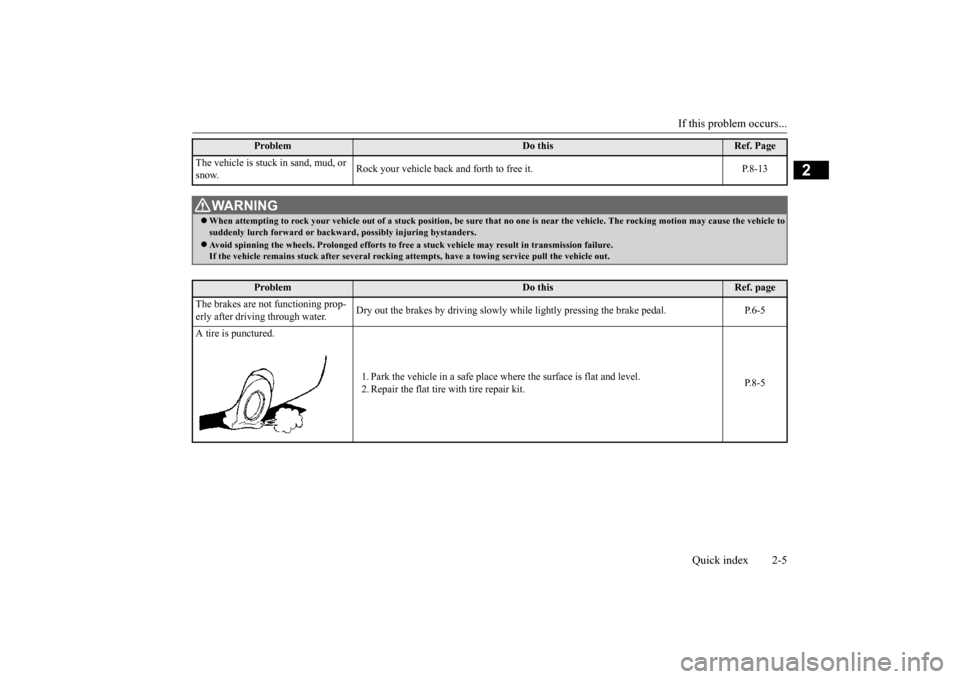
If this problem occurs...
Quick index 2-5
2
The vehicle is stuck
in sand, mud, or
snow.
Rock your vehicle back and forth to free it. P.8-13
WA R N I N G When attempting to rock your vehicle out of
a stuck position, be sure that
no one is near the vehicl
e. The rocking motion may c
ause the vehicle to
suddenly lurch forward or backward, possibly injuring bystanders. Avoid spinning the wheels. Prolonged efforts to free
a stuck vehicle may result
in transmission failure.
If the vehicle remains stuck after several rocking attempts, have a towing service pull the vehicle out.
Problem
Do this
Ref. page
The brakes are not functioning prop- erly after driving through water.
Dry out the brakes by driving slowly whil
e lightly pressing the brake pedal. P.6-5
A tire is punctured.
1. Park the vehicle in a safe place where the surface is flat and level. 2. Repair the flat tire with tire repair kit.
P.8-5
Problem
Do this
Ref. Page
BK0220401US.book 5 ページ 2015年6月3日 水曜日 午前7時42分
Page 131 of 296
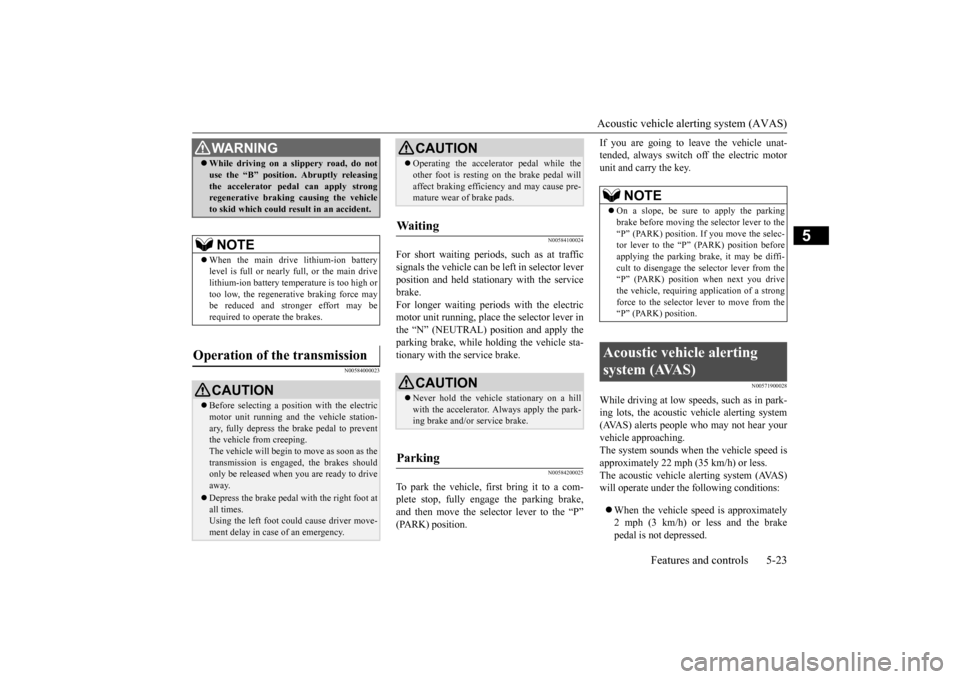
Acoustic vehicle alerting system (AVAS)
Features and controls 5-23
5
N00584000023
N00584100024
For short waiting periods, such as at traffic signals the vehicle can be
left in selector lever
position and held stationary with the service brake. For longer waiting periods with the electricmotor unit running, plac
e the selector lever in
the “N” (NEUTRAL) position and apply the parking brake, while holding the vehicle sta-tionary with the service brake.
N00584200025
To park the vehicle, first bring it to a com-plete stop, fully engage the parking brake, and then move the selector lever to the “P” (PARK) position.
If you are going to leave the vehicle unat- tended, always switch
off the electric motor
unit and carry the key.
N00571900028
While driving at low speeds, such as in park-ing lots, the acoustic vehicle alerting system(AVAS) alerts people who may not hear your vehicle approaching. The system sounds when the vehicle speed isapproximately 22 mph
(35 km/h) or less.
The acoustic vehicle alerting system (AVAS) will operate under th
e following conditions:
When the vehicle sp
eed is approximately
2 mph (3 km/h) or less and the brake pedal is not depressed.
WA R N I N G While driving on a slippery road, do not use the “B” position.
Abruptly releasing
the accelerator pedal can apply strongregenerative braking
causing the vehicle
to skid which could result in an accident.NOTE
When the main drive lithium-ion battery level is full or nearly
full, or the main drive
lithium-ion battery temp
erature is too high or
too low, the regenerative braking force may be reduced and stronger effort may berequired to operate the brakes.
Operation of the transmission
CAUTION Before selecting a pos
ition with the electric
motor unit running and the vehicle station- ary, fully depress the brake pedal to prevent the vehicle from creeping.The vehicle will begin to move as soon as the transmission is engage
d, the brakes should
only be released when you are ready to driveaway. Depress the brake pedal
with the right foot at
all times. Using the left foot could cause driver move- ment delay in case of an emergency.
Operating the accelerator pedal while the other foot is resting
on the brake pedal will
affect braking efficien
cy and may cause pre-
mature wear of brake pads.
Waiting
CAUTION Never hold the vehicle
stationary on a hill
with the accelerator. Always apply the park- ing brake and/or service brake.
Parking
CAUTION
NOTE
On a slope, be sure to apply the parking brake before moving the selector lever to the“P” (PARK) position. If you move the selec- tor lever to the
Page 132 of 296
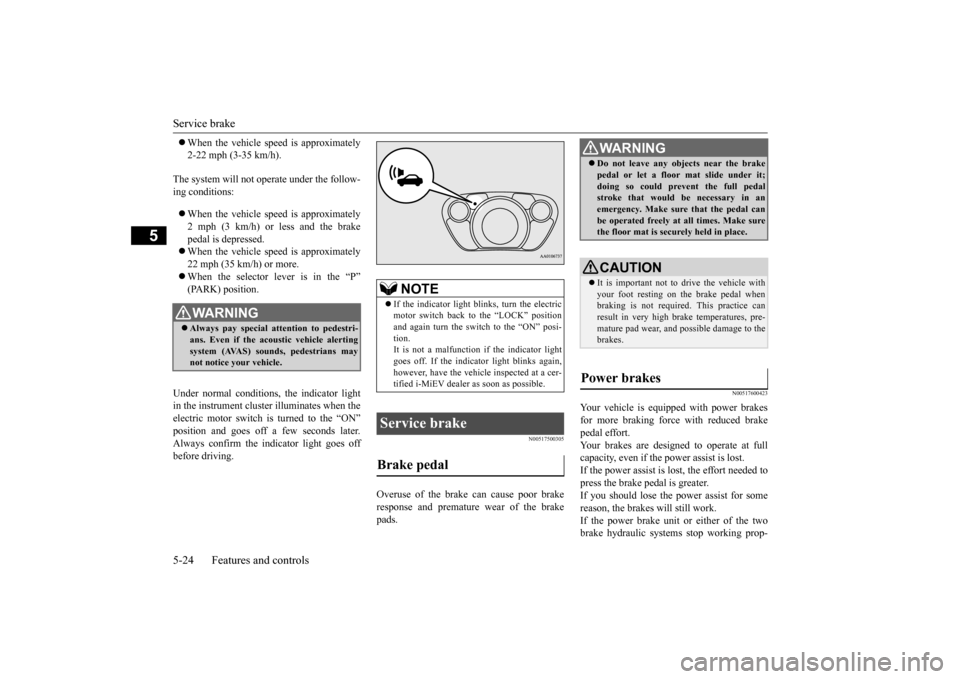
Service brake 5-24 Features and controls
5
When the vehicle sp
eed is approximately
2-22 mph (3-35 km/h).
The system will not operate under the follow- ing conditions: When the vehicle sp
eed is approximately
2 mph (3 km/h) or less and the brake pedal is depressed. When the vehicle sp
eed is approximately
22 mph (35 km/h) or more. When the selector lever is in the “P”
Under normal conditions, the indicator light in the instrument cluster illuminates when theelectric motor switch is turned to the “ON”
few seconds later.
Always confirm the indicator light goes offbefore driving.
N00517500305
Overuse of the brake can cause poor brakeresponse and premature wear of the brakepads.
N00517600423
Your vehicle is equipped with power brakesfor more braking force with reduced brakepedal effort. Your brakes are designed to operate at full capacity, even if the power assist is lost.If the power assist is lost, the effort needed to press the brake pedal is greater. If you should lose the power assist for somereason, the brakes will still work. If the power brake unit or either of the two brake hydraulic systems stop working prop-
WA R N I N G Always pay special attention to pedestri- ans. Even if the acou
stic vehicle alerting
system (AVAS) sounds, pedestrians may not notice your vehicle.
NOTE
If the indicator light blinks, turn the electric motor switch back to the “LOCK” positionand again turn the switch to the “ON” posi- tion. It is not a malfunction if the indicator lightgoes off. If the indica
tor light blinks again,
however, have the vehicl
e inspected at a cer-
tified i-MiEV dealer as soon as possible.
Service brake Brake pedal
WA R N I N G Do not leave any obje
cts near the brake
pedal or let a floor
mat slide under it;
doing so could prevent the full pedalstroke that would be necessary in an emergency. Make sure that the pedal can be operated freely at
all times. Make sure
the floor mat is securely held in place.CAUTION It is important not to drive the vehicle with your foot resting on the brake pedal when braking is not required.
This practice can
result in very high brake temperatures, pre- mature pad wear, and pos
sible damage to the
brakes.
Power brakes
BK0220401US.book 24 ページ 2015年6月3日 水曜日 午前7時42分
Page 133 of 296
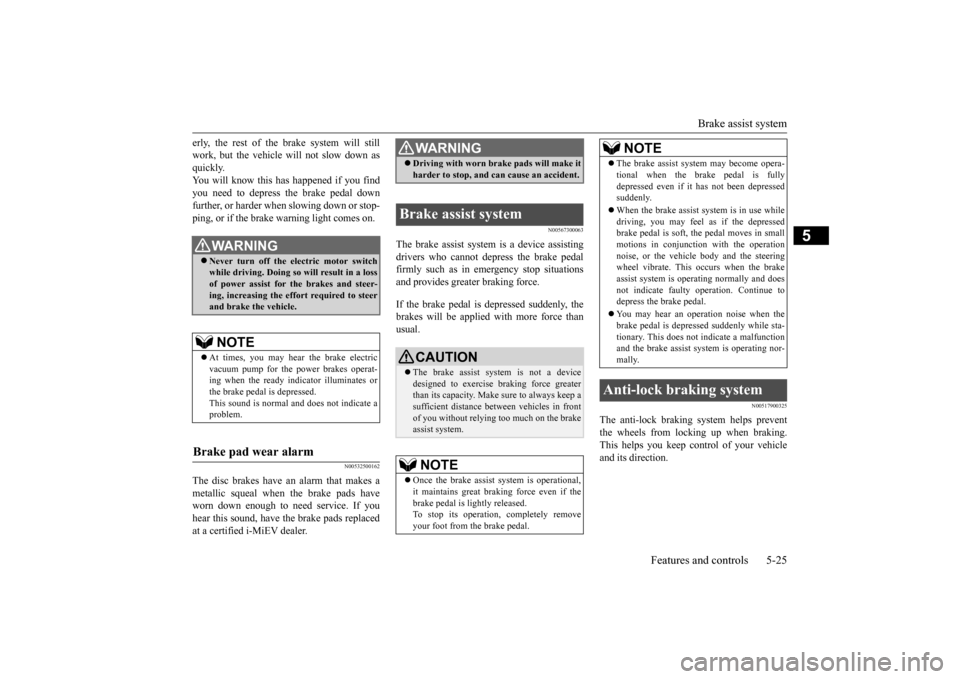
Brake assist system
Features and controls 5-25
5
erly, the rest of the brake system will still work, but the vehicle will not slow down asquickly. You will know this ha
s happened if you find
you need to depress the brake pedal downfurther, or harder when slowing down or stop- ping, or if the brake warning light comes on.
N00532500162
The disc brakes have an alarm that makes ametallic squeal when
the brake pads have
worn down enough to need service. If youhear this sound, have
the brake pads replaced
at a certified i-MiEV dealer.
N00567300063
The brake assist system is a device assisting drivers who cannot depress the brake pedalfirmly such as in em
ergency stop situations
and provides greater braking force. If the brake pedal is depressed suddenly, the brakes will be applied with more force thanusual.
N00517900325
The anti-lock braking
system helps prevent
the wheels from locking up when braking. This helps you keep control of your vehicleand its direction.
WA R N I N G Never turn off the electric motor switch while driving. Doing so will result in a loss of power assist for the brakes and steer-ing, increasing the effort required to steer and brake the vehicle.NOTE
At times, you may hear
the brake electric
vacuum pump for the power brakes operat-ing when the ready i
ndicator illuminates or
the brake pedal is depressed. This sound is normal a
nd does not indicate a
problem.
Brake pad wear alarm
WA R N I N G Driving with worn brake pads will make it harder to stop, and can cause an accident.
Brake assist system
CAUTION The brake assist system is not a device designed to exercise
braking force greater
than its capacity. Make
sure to always keep a
sufficient distance be
tween vehicles in front
of you without relying too much on the brake assist system.NOTE
Once the brake assist system is operational, it maintains great braking force even if the brake pedal is lightly released.To stop its operation, completely remove your foot from the brake pedal.
The brake assist syst
em may become opera-
tional when the brake pedal is fullydepressed even if it
has not been depressed
suddenly. When the brake assist system is in use while driving, you may feel as if the depressed brake pedal is soft, the pedal moves in small motions in conjuncti
on with the operation
noise, or the vehicle body and the steering wheel vibrate. This occurs when the brake assist system is ope
rating normally and does
not indicate faulty
operation. Continue to
depress the brake pedal. You may hear an operation noise when the brake pedal is depre
ssed suddenly while sta-
tionary. This does not
indicate a malfunction
and the brake assist sy
stem is operating nor-
mally.
Anti-lock braking system
NOTE
BK0220401US.book 25 ページ 2015年6月3日 水曜日 午前7時42分
Page 134 of 296
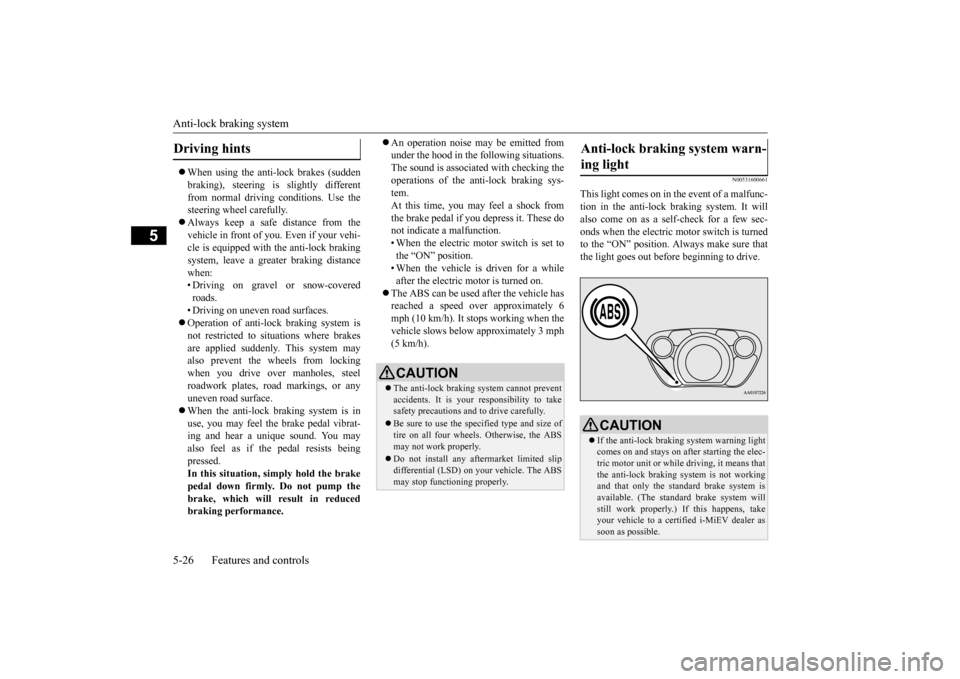
Anti-lock braking system 5-26 Features and controls
5
When using the anti-lock brakes (sudden braking), steering is
slightly different
from normal driving conditions. Use the steering wheel carefully. Always keep a safe distance from the vehicle in front of you. Even if your vehi- cle is equipped with
the anti-lock braking
system, leave a greater braking distance when: • Driving on gravel or snow-covered roads. • Driving on uneven road surfaces. Operation of anti-lock braking system is not restricted to situations where brakes are applied suddenly. This system mayalso prevent the wheels from locking when you drive over manholes, steel roadwork plates, road markings, or anyuneven road surface. When the anti-lock braking system is in use, you may feel the brake pedal vibrat-ing and hear a unique sound. You may also feel as if the pedal resists being pressed.In this situation, simply hold the brake pedal down firmly. Do not pump the brake, which will result in reducedbraking performance.
An operation noise may be emitted from under the hood in the following situations.The sound is associated with checking the operations of the anti-lock braking sys- tem.At this time, you may feel a shock from the brake pedal if you depress it. These do not indicate a malfunction.• When the electric motor switch is set to the “ON” position. • When the vehicle is driven for a while after the electric motor is turned on.
The ABS can be used after the vehicle has reached a speed over approximately 6 mph (10 km/h). It stops working when the vehicle slows below approximately 3 mph(5 km/h).
N00531600661
This light comes on in the event of a malfunc-tion in the anti-lock braking system. It willalso come on as a self-check for a few sec- onds when the electric motor switch is turned to the “ON” position.
Always make sure that
the light goes out befo
re beginning to drive.
Driving hints
CAUTIONThe anti-lock braking system cannot prevent accidents. It is your
responsibility to take
safety precautions and to drive carefully. Be sure to use the spec
ified type and size of
tire on all four wheels. Otherwise, the ABS may not work properly. Do not install any aftermarket limited slip differential (LSD) on your vehicle. The ABSmay stop functioning properly.
Anti-lock braking system warn- ing light
CAUTION If the anti-lock braking system warning light comes on and stays on af
ter starting the elec-
tric motor unit or while driving, it means that the anti-lock braking system is not workingand that only the standard brake system is available. (The standard brake system will still work properly.) If this happens, takeyour vehicle to a certif
ied i-MiEV dealer as
soon as possible.
BK0220401US.book 26 ページ 2015年6月3日 水曜日 午前7時42分
Page 194 of 296

Safe driving techniques 6-4 Driving safety
6
Move the driver’s seat as far backward as possible, while still
keeping good visibil-
ity, and good control of the steering wheel, brakes, accele
rator, and controls.
Check the instrument panel indicators forany possible problem. Move the front passe
nger seat as far back
as possible. Make sure that infa
nts and small children
are properly restrained in accordance with all laws and regulations.
Check these by selecti
ng the defroster mode,
and set the blower swit
ch on high. You should
be able to feel the air blowing against the windshield. (Refer to “Defrosting or defogging the wind- shield and door windows” on page 7-9.) Check all the tires for heavy tread wear or uneven wear patterns.
Look for stones, nails,
glass, or other objects
stuck in the tread. Look
for any tread cuts or sidewall cracks. Check the wheel nuts for tightness, and the tires for proper pressures. Replace your tires beforethey are heavily worn out.
As your vehicle is equi
pped with a tire pres-
sure monitoring system, there is a risk ofdamage to the tire inflation pressure sensors when the tire is replaced on the rim. Tire replacement should, th
erefore, be performed
only by a certified i-MiEV dealer. Have someone watch while you turn all the exterior lights on and off. Also check the turn signal indicators and
high-beam indicators on
the instrument panel. Check the ground under the vehicle after parking overnight, for wa
ter, oil, or other
leaks. Make sure all the fluid levels are cor- rect.
N00629200124
Even this vehicle’s safety equipment, andyour safest driving, cannot guarantee that youcan avoid an accident or injury. However, if you give extra attention to the following areas, you can better protect yourself andyour passengers:
Drive defensively. Be aware of traffic, road and weather conditions. Leave plentyof stopping distance between your vehicle and the vehicle ahead. Before changing lanes, check your mir- rors and use your turn signal light. While driving, watch the behavior of other drivers, bicyc
lists, and pedestrians.
Always obey applicable
laws and regula-
tions. Be a polite and alert driver. Always leave room for unexpected events, such as sudden braking.
N00629400416
Check the 12V starter battery, including terminals and cables. During extremely cold weather, the 12V starter battery willnot be as strong and
its power level may
drop. Before driving the vehicle, check to see ifthe headlights are as bright as normal. Charge or replace the 12V starter battery if necessary. During extreme coldweather, it is possibl
e that a very low 12V
starter battery could freeze.
Defrosters Tires
Lights Fluid leaks Safe driving techniques
Driving during cold weather
BK0220401US.book 4 ページ 2015年6月3日 水曜日 午前7時42分
Page 195 of 296
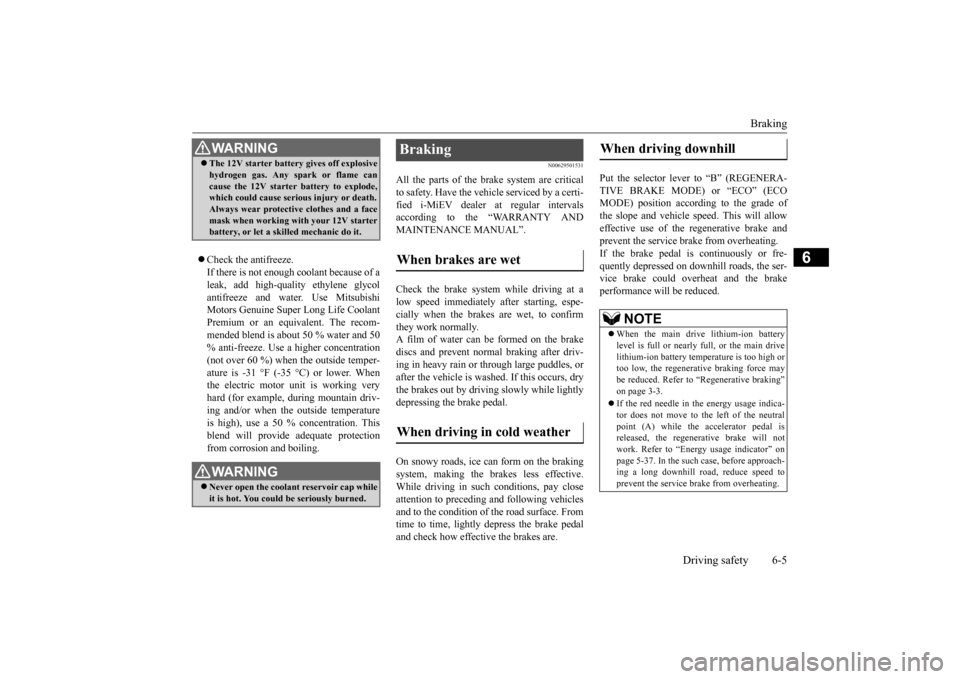
Braking
Driving safety 6-5
6
Check the antifreeze. If there is not enough coolant because of aleak, add high-quality ethylene glycol antifreeze and water. Use Mitsubishi Motors Genuine Super Long Life CoolantPremium or an equivalent. The recom- mended blend is abou
t 50 % water and 50
% anti-freeze. Use a
higher concentration
(not over 60 %) when the outside temper- ature is -31 °F (-35 °C) or lower. When the electric motor unit is working veryhard (for example, during mountain driv- ing and/or when the outside temperature is high), use a 50 %
concentration. This
blend will provide
adequate protection
from corrosion and boiling.
N00629501531
All the parts of the brake system are criticalto safety. Have the vehicle serviced by a certi- fied i-MiEV dealer at regular intervalsaccording to the “WARRANTY AND MAINTENANCE MANUAL”. Check the brake system while driving at a low speed immediately
after starting, espe-
cially when the brakes are wet, to confirm they work normally. A film of water can be formed on the brakediscs and prevent normal braking after driv- ing in heavy rain or through large puddles, or after the vehicle is washed. If this occurs, drythe brakes out by driving slowly while lightly depressing the brake pedal. On snowy roads, ice can form on the braking system, making the brak
es less effective.
While driving in such conditions, pay closeattention to preceding
and following vehicles
and to the condition of the road surface. From time to time, lightly
depress the brake pedal
and check how effective the brakes are.
Put the selector lever to “B” (REGENERA- TIVE BRAKE MODE) or “ECO” (ECO MODE) position according to the grade ofthe slope and vehicle sp
eed. This will allow
effective use of the regenerative brake and prevent the service brake from overheating.If the brake pedal is continuously or fre- quently depressed on downhill roads, the ser- vice brake could overheat and the brake performance will be reduced.
WA R N I N G The 12V starter batter
y gives off explosive
hydrogen gas. Any spark or flame cancause the 12V starter battery to explode,which could cause serious injury or death. Always wear protecti
ve clothes and a face
mask when working wi
th your 12V starter
battery, or let a skil
led mechanic do it.
WA R N I N GNever open the coolan
t reservoir cap while
it is hot. You could be seriously burned.
Braking When brakes are wet When driving in cold weather
When driving downhill
NOTE
When the main drive lithium-ion battery level is full or nearly full, or the main drivelithium-ion battery temp
erature is too high or
too low, the regenerative braking force may be reduced. Refer to “Regenerative braking”on page 3-3. If the red needle in the energy usage indica- tor does not move to the left of the neutral point (A) while the
accelerator pedal is
released, the regenerative brake will notwork. Refer to “Ener
gy usage indicator” on
page 5-37. In the such
case, before approach-
ing a long downhill
road, reduce speed to
prevent the service brake from overheating.
BK0220401US.book 5 ページ 2015年6月3日 水曜日 午前7時42分
Page 197 of 296

Loading information Driving safety 6-7
6
It is important to famil
iarize yourself with the
following terms before loading your vehicle: Vehicle maximum load on the tire: load on an individual tire that is determined bydistributing to each axle its share of the maximum loaded vehicle weight and dividing by two. Vehicle normal load on the tire: load on an individual tire that is determined by dis- tributing to each axle its share of the curbweight, accessory weight, and normal occupant weight and dividing by two. Maximum loaded vehicle weight: the sum of - (a) Curb weight; (b) Accessory weight;(c) Vehicle capacity weight; and (d) Production options weight. Curb weight: the weight of a motor vehi- cle with standard e
quipment including the
maximum capacity of oil, and coolant.
Accessory weight: the combined weight (in excess of those st
andard items which
may be replaced) of automatic transmis- sion, power steering, power brakes, power windows, power seats,
radio, and heater,
to the extent that these items are available as factory- installe
d equipment (whether
installed or not). Vehicle capacity weight: the rated cargo and luggage load plus 150 lbs (68 kg)
*
times the vehicle’s designated seating capacity. Production options weight: the combined weight of those installed regular produc- tion options weighing over 5 lbs (2.3 kg) in excess of those standard items whichthey replace, not prev
iously considered in
curb weight or accessory weight, includ- ing heavy duty brakes,
ride levelers, roof
rack, heavy duty battery, and special trim. Normal occupant weight: 150 lbs (68 kg)
*
times the number of specified occupants.(In your vehicle the number is 2) Occupant distributi
on: distribution of
occupants in a vehicle as specified. (Inyour vehicle the distribution is 2 in front seat)
N00630100370
The tire and loading information placard is located on the driver’s door sill. This placard shows the maximum number of occupants permitted to
ride in your vehicle as
well as “the combined
weight of occupants
and cargo” (C), which
is called the vehicle
capacity weight. This
placard also tells you
the size and recomme
nded inflation pressure
for the original equipment tires on your vehi-cle. For more information, refer to “Tires” on page 9-10.
WA R N I N G Never overload your ve
hicle. Overloading
can damage your vehicl
e, adversely affect
vehicle performance, including handlingand braking, cause tire failure, and result in an accident.
* : 150 lbs (68 kg) is the weight of one per- son as defined by U.S.A. and Canadian regulations.
Tire and loading information placard
BK0220401US.book 7 ページ 2015年6月3日 水曜日 午前7時42分